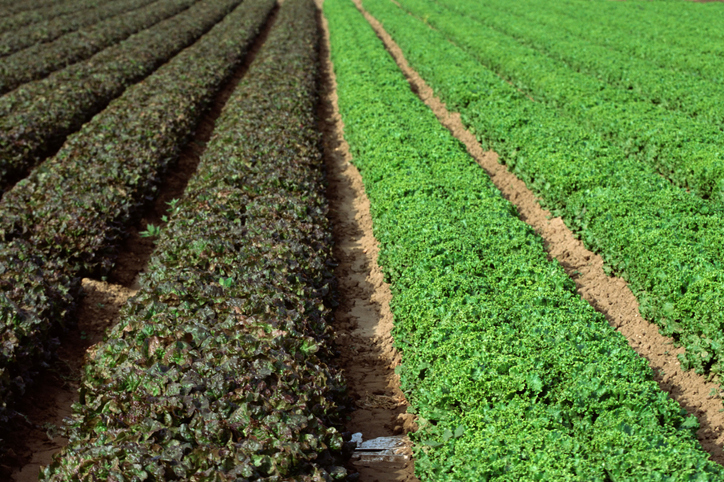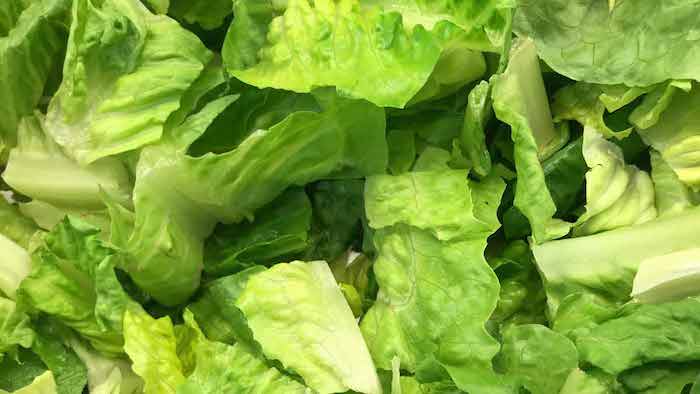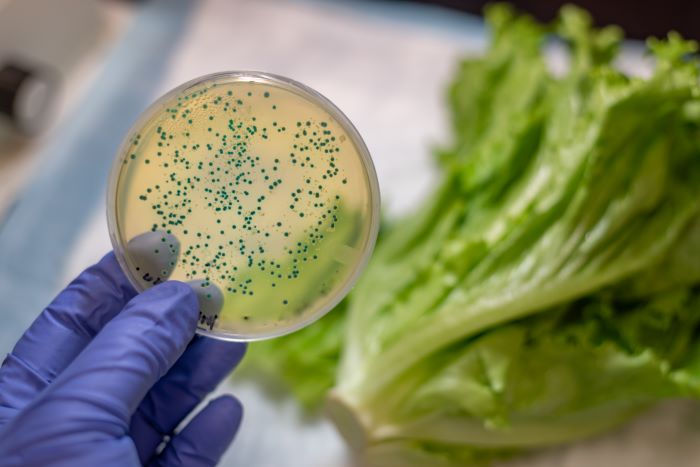The U.S Food and Drug Administration (FDA) is out with a new report on three romaine lettuce E. coli O157: H7 outbreaks that occurred last year. Though the 18-page report details the agency’s findings of three 2019 outbreaks linked to romaine lettuce grown in Salinas, California, it sounds pretty similar to a report the agency issued on a deadly E. coli outbreak in 2018 that was linked to romaine lettuce grown in Yuma, Arizona. Here are the three key similarities:
- FDA believes nearby cattle feeding or grazing operations to be the source of the E. coli.
- FDA was not allowed access to these operations
- FDA made recommendations (not mandates) for lettuce growers to mitigate E. coli risks of nearby cattle operations.
Before comparing the FDA reports, here is some basic information about E. coli O157: H7, where our nation’s lettuce is grown and a brief summary of Yuma and Salinas outbreaks.
What is E. coli O157: H7 and Where Does it Come From?
E. coli O157: H7 is a serotype of E. coli discovered in 1982. It is one of a small group of E. coli serotypes that produces a kind of poison called a Shiga toxin. In humans, Shiga toxins can cause a type of kidney failure called hemolytic uremic syndrome (HUS), other severe illnesses and death.
Harmless serotypes of E. coli live in the intestines of all animals, including humans, where they aid in the digestion of food. But E. coli O157: H7 only naturally exists in the intestines of ruminant animals. Cattle are the primary reservoir.
People get sick from E. coli O157: H7 when they ingest food or beverages that are contaminated with microscopic amounts of feces from a ruminant animal or from an infected human. People can also get E. coli O157: H7 infections by touching animals at petting zoos or other animal exhibits and then touching their mouths or eating food without washing their hands first.
Almost All Lettuce Grown in U.S. Comes from 2 States
Almost all lettuce grown in the U.S. is produced in two states. California and Arizona grow about 90 percent of the nation’s leafy greens dividing the year between them. In October and November, production transitions to Arizona. In March and April, it shifts back to California.
In 2006, an E. coli O157: H7 outbreak linked to fresh spinach grown in California sickened 200 people. One hundred and two people were hospitalized, 31 of them with HUS. Three people died, one of them was a two-year-old child.
After this outbreak, California farmers developed a coalition that worked with university and industry scientists, food safety experts, government officials, and shipping and processing companies to create a science-based food safety system. It’s called the California Leafy Greens Marketing Association. Arizona then developed a similar program.
Farmers who are members of these groups agree to mandatory government audits provided by USDA-certified, government inspectors, are audited multiple times a season and must achieve 100 percent compliance with the LGMA food safety practices, according to the California LGMA website. A list of their member companies is here.
Here are the five areas, the California LGMA’s safety practices cover.
- General Requirements – “Member companies are required to have a complete food safety compliance plan, an up-to-date list of growers, and a written traceback program.”
- Environmental Assessment – “Pre-season and pre-harvest assessments are required to make sure conditions that can affect food safety, such as animal intrusions, flooding, proximity to animal feeding operations, etc. are not present, or have been properly mitigated.”
- Water Use – “Extensive testing and record-keeping for all sources of water used in the production of leafy greens is required.” After recent outbreaks, water usage metrics were updated.
- Soil Amendments – “Extensive testing, certification and record-keeping for soil amendments, including compost and fertilizers, are required by the program.
- Work Practices and Field Operations – “Field audits verify that farmers are in compliance with the program’s requirements in the areas of worker practices and field sanitation. The LGMA food safety practices are grounded in the latest food safety science, and are updated as new research and information becomes available.”
The 2018 Yuma-Grown Romaine Lettuce E. coli Outbreak
Between March 13, 2018 and June 6, 2018, 210 people in 36 states developed E. coli O157: H7 infections from romaine lettuce grown in Yuma, AZ. Ninety-six people were hospitalized, 27 developed HUS. Five people died.
When the FDA conducted a “traceback” investigation of the outbreak to determine its source, it wasn’t able to narrow it down to a single grower, processor or distributor, only that the implicated lettuce was grown in Yuma.
So the Centers for Disease Control and Prevention (CDC) and FDA advised consumers not to eat and restaurants and retailers not to sell romaine lettuce grown in Yuma. But consumers quickly discovered that “state of origin” information doesn’t appear on all forms of romaine sold at grocery stores. To make matters worse, some stores issued recalls, some restaurants stopped serving romaine and some romaine producers issued statements saying their lettuce is not implicated in the outbreak, including one company based in Yuma, AZ.
Related
Romaine E. coli Outbreak Kills Five, 26 Have HUS Kidney Failure
FDA: Large Cattle Farm May Be Romaine Lettuce E. coli Outbreak Source
Yuma Growing Season Begins Under Shadow of Deadly E. coli Outbreak
The 2019 Outbreaks Linked to Salinas-Grown Romaine Lettuce
In 2019, three E. coli O157:H7 outbreaks linked to romaine lettuce sickened a total of 188 people. Ninety-two people were hospitalized, 16 developed HUS. No fatalities were reported. In its new report, the FDA refers to these outbreaks as A, B, C.
Outbreak A
Announced on November 20, 2019, this romaine E. coli outbreak sickened 167 people in 27 states Eighty-five people were hospitalized, 15 developed HUS. Illnesses from the outbreak strain were also reported in Canada. Investigators also discovered that this outbreak strain was linked to a 2018 romaine outbreak (not the Yuma-grown one) and a 2017 outbreak linked to leafy greens.
On November 18, the Maryland Department of Health tested salad products collected from people who were sickened. They found that romaine lettuce from an intact sample of Ready Pac Bistro® Chicken Caesar Salad was positive for the outbreak strain of E. coli O157: H7.
The FDA and state agriculture officials determined that the romaine lettuce in the implicated product was supplied by three growers in Salinas. Ready Pac is a member of the LGMA.
On December 10, 2019, Wisconsin state health officials reported that they found the E. coli outbreak strain in a sample of Fresh Express Leafy Green Romaine obtained from the household of an ill person. State and federal investigators traced the romaine in this product to two growers in Salinas. Fresh Express is a member of the LGMA.
Outbreak B
On November 26, 2019, the King County Health Department in Washington State announced an E. coli outbreak linked to leafy greens sold at Evergreens restaurants. The outbreak, linked to several locations, sickened 11 people hospitalizing three of them. Investigators determined that the leafy greens were grown in Salinas.
Outbreak C
On December 9, 2019, an E. coli outbreak linked to Fresh Express Sunflower Crisp Chopped Salad Kits was announced. The outbreak sickened 10 people in five states. Four people were hospitalized and one of them developed HUS. Illnesses were also reported in Canada. Investigators determined that the romaine lettuce in these salad kits was sourced from Salinas.
FDA Investigation Reports Have Similar Suggestions
After the Yuma outbreak and the 2019 outbreaks, the FDA conducted an environmental assessment to get to the root cause. In the Yuma investigation, a large concentrated animal feeding operation (CAFO) for cattle neighbored some the growing areas. In the 2019 outbreaks, grazing and feeding operations are also near the Salinas growing regions.
In the Yuma investigation, the FDA found the outbreak strain in three places along a 3.5 mile stretch in an irrigation canal. In the 2019 investigation, the agency found the outbreak strain on a fecal/soil sample collected from a cattle grate within two miles of a farm linked to the outbreak.
In both reports, the FDA states that it could not find an “obvious route” for contamination from the neighboring cattle operations. But the 2019 report states that there are three ways the transmission could have happened: run-off, contamination of agricultural water and direct transmission by “wind, animals or farming activities such as vehicles, harvest crews, or harvest equipment.”
The FDA makes note in each report that its access to anything but the romaine farms and public lands was limited. After being denied access to the CAFO adjacent to the Yuma growing fields, U.S. Rep. Roas DeLauro (D- CT) and U.S. Sen. Kirstin Gillibrand (D- NY) sponsored a bill called the Expanded Food Safety Investigation Act of 2019 that would have given the FDA the authority to collect samples from CAFOs in their investigations of foodborne illness outbreaks. It was referred to the House subcommittee on Health in December 2019.
Another big gap in information was revealed in the 2019 report where the FDA revealed it was not able to investigate the harvesting crews, packers or processors and was therefore “unable to determine if post-harvest water was safe and adequate for its intended use.”
At the end of each report, the FDA made a handful of recommendations, most of them were the same, such as:
- Assure that all agricultural water used by growers is safe and adequate for its intended use.
- Assess and mitigate risks associated with adjacent and nearby land uses, including grazing lands and animal operations regardless of size.
- Improve root cause analysis.
How Long Will We Be Stuck in This Cycle?
Between 2009 and 2018, 40 E. coli outbreaks were linked to leafy greens. In the FDA’s own words, there is more work to be done.
“Due to persistent E. coli O157:H7 outbreaks associated with leafy greens from the western/southwestern U.S., particularly romaine lettuce, and because of the magnitude of this and recent associated outbreaks, working with our state partners, FDA is in the process of conducting in-depth, follow-up investigations this growing season. The investigations may further characterize how contamination might have occurred and may inform what preventive measures are needed to prevent future outbreaks. Once complete, FDA will promptly issue a report and share lessons learned, so that growers can implement preventive measures to protect consumers from contaminated produce.”


